Hemostasis/Coagulation Analyzer Market Size and Trends
Global hemostasis/coagulation analyzer market is estimated to be valued at USD 4.62 Bn in 2025 and is expected to reach USD 6.95 Bn by 2032, exhibiting a compound annual growth rate (CAGR) of 6.0% from 2025 to 2032.
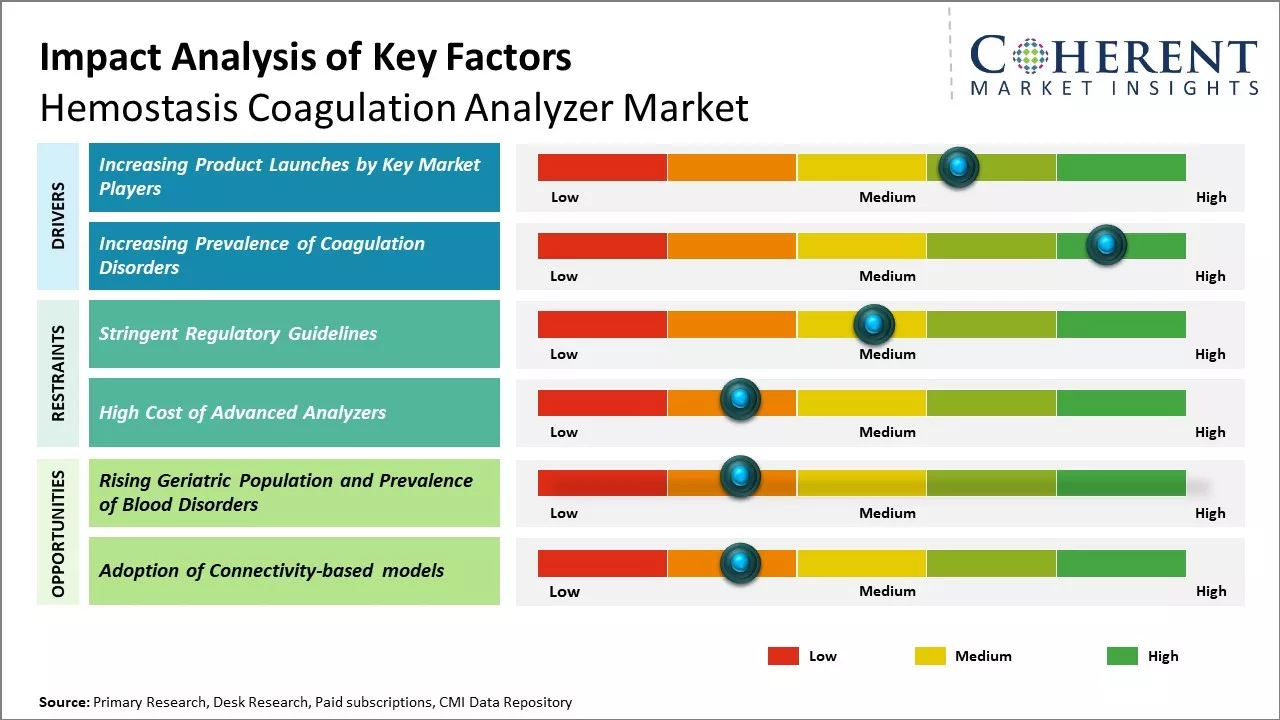
Discover market dynamics shaping the industry: Download Free Sample
The hemostasis/coagulation analyzer market is expected to witness significant growth over the forecast period. The rising prevalence of chronic diseases and increasing demand for home healthcare are expected to drive the market growth. Additionally, the growing demand for biological drugs and self-administration are encouraging pharmaceutical companies to invest more in developing advanced drug delivery systems like dual chamber prefilled syringes.
Market Driver – Increasing Product Launches by Key Market Players
Increasing adoption of organic growth strategies such as product launches by key market players is expected to drive the global hemostasis/coagulation analyzer market growth over the forecast period. For instance, in October 2021, Trivitron Healthcare, a medical device company, announced the launch of new line of Coagulation Analyzer products manufactured by Diagon Ltd., a medical technology company. The new products include the COAG Line automated, semi-automated, and POC systems manufactured by Diagon Hungary for reducing bleeding risk in extensive surgeries, checking the efficacy of haemostatic therapies and anti-coagulant drugs.
Market Concentration and Competitive Landscape
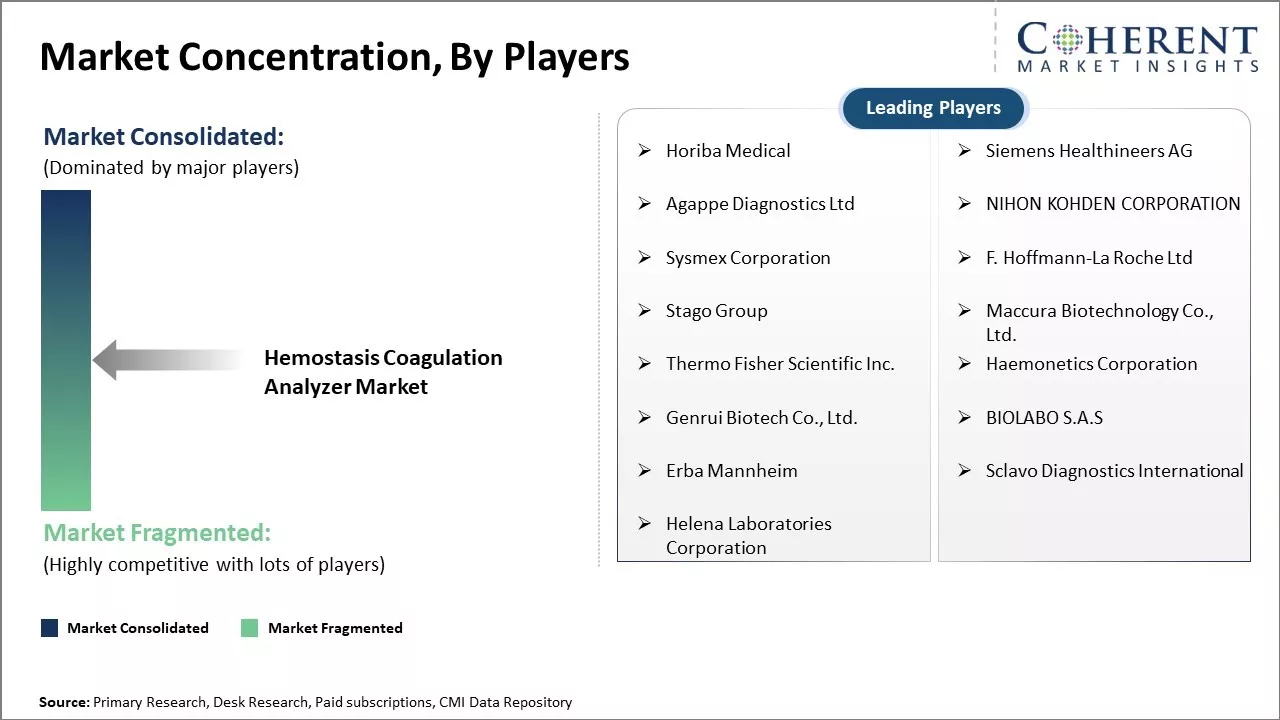
Get actionable strategies to beat competition: Download Free Sample
Market Driver – Increasing Prevalence of Coagulation DisordersThe global prevalence of coagulation disorders has been on the rise over the past few decades. Various chronic medical conditions that impair the body's natural blood clotting processes have become more common worldwide. Inherited bleeding disorders like hemophilia A and B affect over 400,000 people globally and the incidence of acquiring these genetic conditions is going up annually. Moreover, lifestyle-related illnesses such as liver disease, kidney failure, and cancer which disrupt the normal homeostasis of coagulation factors in the bloodstream have witnessed a rise coinciding with changing demographics and risk factors. As these patient populations expand, the need for frequent monitoring and management of their coagulation status will drive greater demand for hemostasis analyzers.
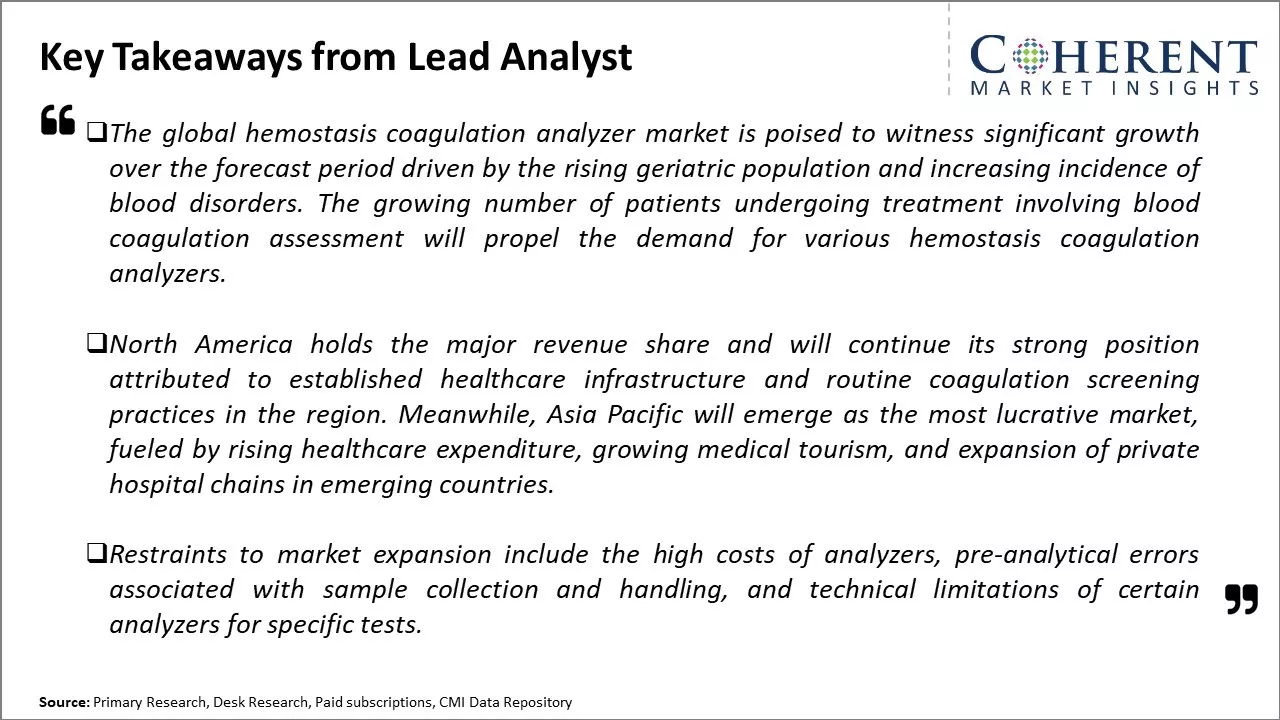
To learn more about this report, Download Free Sample
Market Challenges – Stringent Regulatory GuidelinesStringent regulatory guidelines from governments across the globe are posing a major challenge for the growth of the global hemostasis and coagulation analyzer market. Various jurisdictions have implemented strict rules and protocols surrounding the sale, distribution and use of medical devices like hemostasis analyzers due to patient safety concerns. Complying with these regulations involves lengthy product approval processes, adherence to quality standards and post-market surveillance practices that substantially increase the cost and time taken for these advanced diagnostic platforms to reach the end users.
Market Opportunities – Rising Geriatric Population and Prevalence of Blood Disorders
The rising geriatric population and prevalence of blood disorders could provide significant opportunities for growth in the global hemostasis/coagulation analyzer market. As per United Nations data, the number of people aged 65 years and above is projected to grow from 727 million currently to over 1.5 billion by 2050 globally. With ageing comes increased vulnerability to various blood disorders and coagulation-related diseases. According to estimates by the World Health Organization, annual deaths due to cardiac failure are projected to rise to over 23 million worldwide by 2030. Many cardiac ailments have underlying issues related to blood coagulation abnormalities.
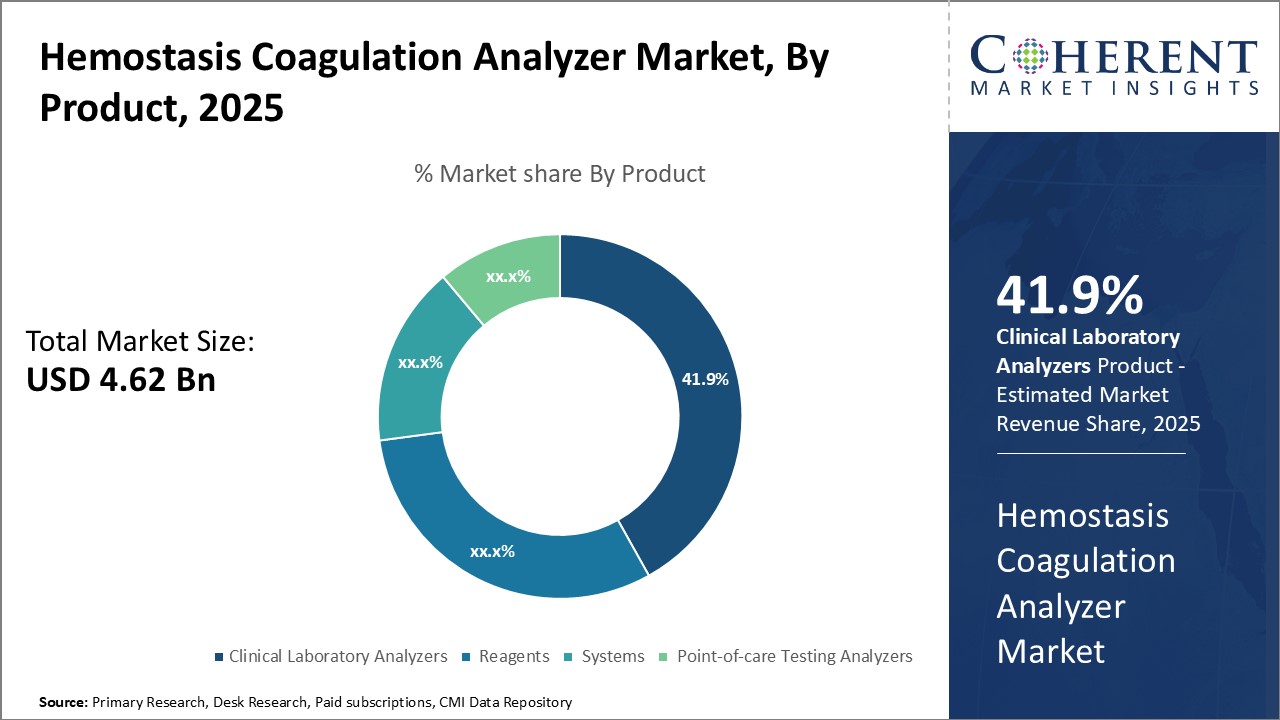
Discover high revenue pocket segments and roadmap to it: Download Free Sample
Insights, By Product: Clinical Efficacy Drives Adoption of Clinical Laboratory AnalyzersProduct segment is sub-segmented into clinical laboratory analyzers, reagents, systems, and point-of-care testing analyzers. Clinical laboratory segment is estimated to hold 41.9% of the market share in 2025 due to their high accuracy and efficiency in analyzing hemostasis and coagulation parameters directly from blood samples in clinical laboratories. Clinical laboratory analyzers offer automated, standardized analysis of test samples while minimizing human errors. Their high-throughput capabilities allow clinical laboratories to process large test volumes quickly and deliver rapid turnaround times for critical coagulation tests. This ensures timely diagnosis and clinical decision making. Furthermore, clinical laboratory analyzers integrate a variety of assays to generate comprehensive hemostasis and coagulation profiling with just a single sample, eliminating the need for repeat fingertip punctures. Their automated format improves workflow efficiency in labs and frees up technicians for other important tasks. Ongoing technological advancements are further enhancing the accuracy, reproducibility and efficiency of these gold standard analyzers.
Insights, By Technology: Optical Technology Optimizes Sample Analysis
Technology segment is sub-segmented into optical, mechanical, electrochemical, and others. Optical segment is estimated to hold 35.2% of the market share in 2025 owing to its non-invasive, direct measurement capabilities. Optical hemostasis analyzers utilize light scattering, light transmission, or absorption techniques to directly analyze fresh whole blood or plasma samples without any sample preparation or pretreatment steps. This allows for rapid, same-day testing and reporting of results to facilitate quick clinical decision making. Compared to other technologies, optical analysis offers high precision and reproducibility. It can accurately detect even subtle changes in coagulation parameters due to its sensitive optical detection methods. Further, optical instruments have smaller footprints and offer lower running costs due to inexpensive, non-proprietary consumables. Their cartridge-based walkaway format with minimal user intervention optimizes work efficiency in busy hospital laboratories and clinics.
Insights, End User: Growing Testing Volumes in Clinical Laboratories
End User segment is sub-segmented into clinical laboratories, hospitals, and others. Clinical Laboratories segment is estimated to hold 45.2% of the market share in 2025. Clinical laboratories are experiencing rising test volumes owing to the growing prevalence of cardiac, blood, and liver conditions that require routine monitoring of hemostasis function. Furthermore, the rising geriatric population, which is at an increased risk of coagulation diseases and related complications, is also driving up demand for specialized coagulation testing. Clinical laboratories play a key role in standardized, high-volume analysis of these critical tests. They possess technically qualified personnel and fully automated, high-throughput instruments to efficiently meet hospitals' testing requirements within tight turnaround times. Ongoing test menu expansion with novel assays and integrated analyzers will continue promoting their dominance in this end user segment.
Regional Insights
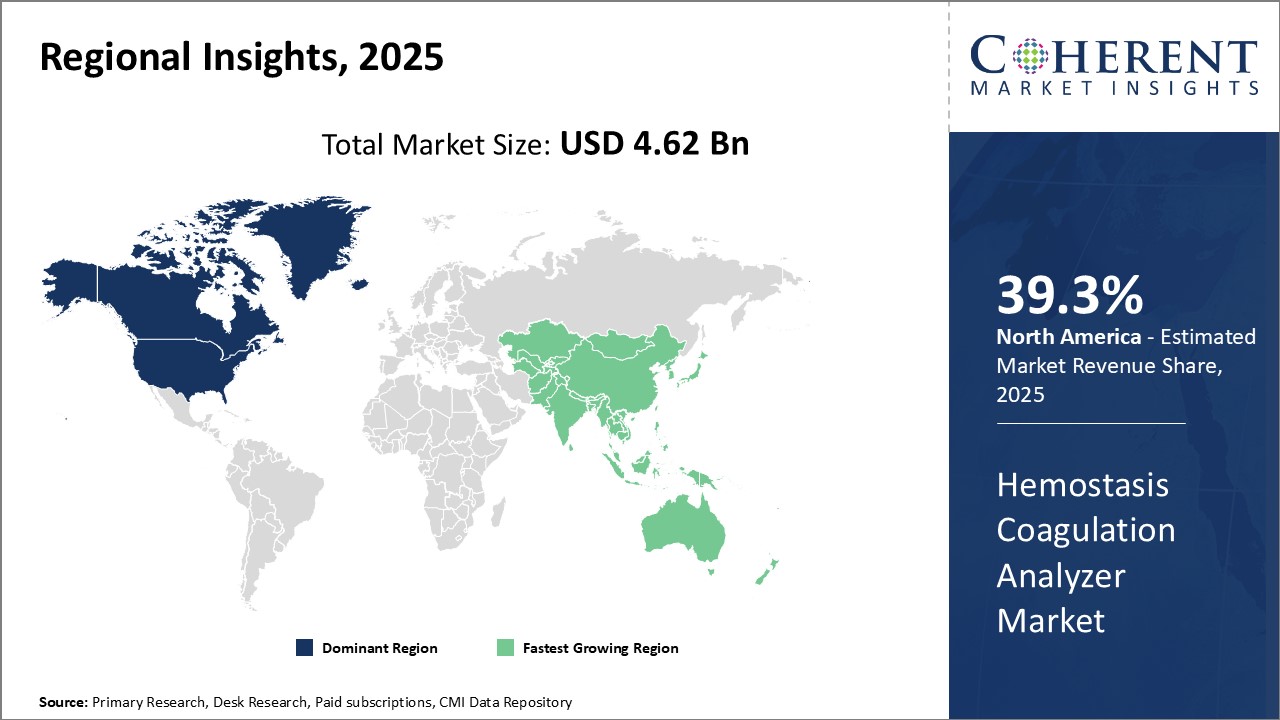
Need a Different Region or Segment? Download Free Sample
North America remains the dominant region in the global hemostasis/coagulation analyzer market and is estimated to hold 39.3% of the market share in 2025. The presence of major players in countries like the U.S. and Canada have contributed to North America's large share. Hemostasis coagulation analyzer manufactured by key market players gains revenue from hospitals, diagnostic centers, and laboratories. Further, constant technological advancements introduced by these players to improve testing capabilities and efficiency have helped sustain demand. For instance, improved connectivity and advanced modular analyzer platforms allow for fast, automated and simultaneous multi-assay testing using small sample volumes.
Asia Pacific is touted as the fastest growing regional market. Rapid economic development and rising healthcare expenditure has boosted the region's clinical diagnostics industry. Asia Pacific countries like China, India, and South Korea are investing heavily in the expansion and modernization of their healthcare systems. Rising medical tourism and easy availability of low-cost treatment and diagnostics are attracting patients from other regions to the Asia Pacific. This is positively impacting the uptake of hemostasis analyzers. Local analyzer manufacturers in Asia Pacific countries are gaining ground by introducing competitive, application-specific products tailored to suit regional requirements and budgets. Overall, the combination of industry growth, developing healthcare infrastructure and supportive government policies are positioning Asia Pacific as a lucrative future market for hemostasis coagulation analyzer companies.
Market Report Scope
Hemostasis/Coagulation Analyzer Market Report Coverage
| Report Coverage | Details | ||
|---|---|---|---|
| Base Year: | 2024 | Market Size in 2025: | USD 4.62 Bn |
| Historical Data for: | 2020 To 2024 | Forecast Period: | 2025 To 2032 |
| Forecast Period 2025 to 2032 CAGR: | 6.0% | 2032 Value Projection: | USD 6.95 Bn |
| Geographies covered: |
|
||
| Segments covered: |
|
||
| Companies covered: |
Horiba Medical, Siemens Healthineers AG, Agappe Diagnostics Ltd, NIHON KOHDEN CORPORATION, Sysmex Corporation, F. Hoffmann-La Roche Ltd, Stago Group, Maccura Biotechnology Co., Ltd., Thermo Fisher Scientific Inc., Haemonetics Corporation, Genrui Biotech Co., Ltd., BIOLABO S.A.S, Erba Mannheim, Sclavo Diagnostics International, and Helena Laboratories Corporation |
||
| Growth Drivers: |
|
||
| Restraints & Challenges: |
|
||
Uncover macros and micros vetted on 75+ parameters: Get instant access to report
Hemostasis/Coagulation Analyzer Industry News
- In May 2023, Horiba Medical, a medical device company, announced that it had showcased its Yumizen G range of hemostasis analyzers and reagents at ISTH 2022 Congress - the premier event in the field of thrombosis and hemostasis - at London’s Excel from July 9-13, 2022
- In March 2023, Sysmex Corporation, a medical technology company, announced the global supply agreement with Siemens Healthineers AG, a global healthcare company, for hemostasis instruments and reagents. Under the terms of agreement, the companies will provide each other with their hemostasis products on an original equipment manufacturer basis. They will then market the products in the combined portfolio under their respective brands.
*Definition: The Hemostasis/Coagulation Analyzer Market consists of companies that manufacture medical devices used to analyze blood clotting disorders and platelet conditions. These analyzers help test parameters related to hemostasis like prothrombin time, activated partial thromboplastin time, fibrinogen assays, D-dimer assays, factor assays and platelet function tests. They provide quick and accurate results to doctors and laboratories to aid in diagnosing bleeding disorders and assessing patients' risk of thrombosis or other
Market Segmentation
- Product Insights (Revenue, USD Bn, 2020 - 2032)
- Clinical Laboratory Analyzers
- Reagents
- Systems
- Point-of-care Testing Analyzers
- Test Insights (Revenue, USD Bn, 2020 - 2032)
- Prothrombin Time Testing
- Fibrinogen Testing
- Activated Clotting Time Testing
- Platelet Function Tests
- Anti-Factor XA Tests
- Others
- Technology Insights (Revenue, USD Bn, 2020 - 2032)
- Optical
- Mechanical
- Electrochemical
- Others
- End User Insights (Revenue, USD Bn, 2020 - 2032)
- Clinical Laboratories
- Hospitals
- Others
- Regional Insights (Revenue, USD Bn, 2020 - 2032)
- North America
- U.S.
- Canada
- Latin America
- Brazil
- Argentina
- Mexico
- Rest of Latin America
- Europe
- Germany
- U.K.
- Spain
- France
- Italy
- Russia
- Rest of Europe
- Asia Pacific
- China
- India
- Japan
- Australia
- South Korea
- ASEAN
- Rest of Asia Pacific
- Middle East
- GCC Countries
- Israel
- Rest of Middle East
- Africa
- South Africa
- North Africa
- Central Africa
- North America
- Key Players Insights
- Horiba Medical
- Siemens Healthineers AG
- Agappe Diagnostics Ltd
- NIHON KOHDEN CORPORATION
- Sysmex Corporation
- F. Hoffmann-La Roche Ltd
- Stago Group
- Maccura Biotechnology Co., Ltd.
- Thermo Fisher Scientific Inc.
- Haemonetics Corporation
- Genrui Biotech Co., Ltd.
- BIOLABO S.A.S
- Erba Mannheim
- Sclavo Diagnostics International
- Helena Laboratories Corporation
Share
Share
About Author
Vipul Patil is a dynamic management consultant with 6 years of dedicated experience in the pharmaceutical industry. Known for his analytical acumen and strategic insight, Vipul has successfully partnered with pharmaceutical companies to enhance operational efficiency, cross broader expansion, and navigate the complexities of distribution in markets with high revenue potential.
Missing comfort of reading report in your local language? Find your preferred language :
Transform your Strategy with Exclusive Trending Reports :
Frequently Asked Questions
EXISTING CLIENTELE
Joining thousands of companies around the world committed to making the Excellent Business Solutions.
View All Our Clients
